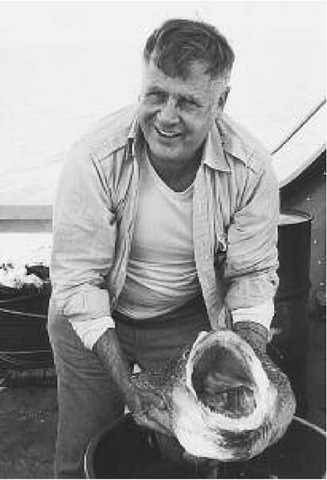(1926- ) American Geochemist, Oceanographer
If there were an Indiana Jones of the Earth sciences, it would be Harmon Craig. Not only does he work on some of the most important problems in Earth science, he does it while having the most daring of adventures. If he is not sailing over the top of an erupting submarine volcano or descending into the crater of an active underwater volcano, he might be captured by Zairian gunboats at gunpoint on Lake Tanganyika or robbed by Masai warriors at spear point.
Harmon Craig is an isotope geochemist who specializes in using helium isotope ratios as a tracer to track the release of gases from the deep interior of the Earth into the oceans and atmosphere. He discovered that the rare isotope helium 3 was trapped in the Earth at the time of formation 4.5 billion years ago and it is being continuously released by degassing from the Earth’s mantle through mid-ocean ridge volcanoes and seafloor vents. This discovery has led to a greater understanding of how the oceans and atmosphere were formed in the primordial Earth. It also led Craig to search worldwide for mantle plumes or hot spots that tap the deep mantle near the Earth’s core and release this helium 3 in higher quantity than in the mid-ocean ridges. He sampled volcanic rocks and gases in the East African Rift Valley from northern Ethiopia to Lake Nyasa, in the Dead Sea, in Tibet and Yunnan, China, and in all of the volcanic chains in the Pacific and Indian Oceans. He has identified 16 such volcanic hot spots with deep mantle signatures, 14 in ocean islands and two on continents in the Afar Depression of Ethiopia and Yellowstone Park, Wyoming.
In this research, while using the Scripps Institution of Oceanography Deep-Tow vehicle, Craig discovered hydrothermal sea vents in the Galapagos Islands seafloor-spreading center. Using the submersible vehicle ALVIN he discovered similar vents on the Loihi seamount to the east of the island of Hawaii and the next Hawaiian island when it reaches the surface. He also sampled gas and rocks from the Macdonald Seamount in the Tubuai Island chain. He found more vents in ALVIN in back arc basins of the Mariana Trough some 12,000 feet below sea level.
Through this worldwide tracking of helium 3 within ocean water, he discovered that the deep water of the south Pacific Ocean circulates in the opposite direction than had previously been described and a symmetrical circulation cell exists in the north Pacific as well. Through similar deepwa-ter circulation studies, Craig found that the element lead is rapidly scavenged by particulate material, the method by which many trace metals are removed from the ocean.
Craig was also involved with the analysis of gas trapped in Greenland ice cores. He discovered that the methane content of the atmosphere has doubled over the past 300 years. This finding has important implications for climate change modeling. He is currently measuring temperatures of past ice ages using his discovery that noble gases are gravitationally enriched in polar ice as a function of temperature.
Craig and his wife, Valerie, have an ongoing project to show the source of marble in ancient Greek sculptures and temples using carbon and oxygen isotopes.
Harmon Craig was born on March 15, 1926, in New York City. He enlisted in the U.S. Navy in 1944 during the later stages of World War II and served as a communications and radar officer on the USS E-LSM until 1946. He attended college at the University of Chicago, Illinois, and completed his doctorate in geology in 1951. He was an advisee of Nobel Prize laureate Harold Urey in the chemistry department. Harmon Craig married his wife, Valerie, in 1947 and they had three children. He was a research associate in geochemistry at the Enrico Fermi Laboratory at the University of Chicago, Illinois, from 1951 to 1955. He joined the faculty at the Scripps Institution of Oceanography in 1955 and remained there for the rest of his career. He was a member of numerous oceano-graphic research expeditions including Monsoon in 1961, Zephyrus in 1962, Carrousel in 1964, Nova in 1967, Scan in 1970, and Antipode in 1971. He was also a member of several expeditions for Geochemical Oceanic Section Study (GEOSECS) in 1972-1977, 1982, 1983, 1985, and several expeditions to the eastern Pacific, Tibet, and China (between 1973 and 1993). He was the director of GEOSECS in 1970.
Harmon Craig aboard a Scripps Institution research vessel shows a fish that was accidentally speared by an arm of the ALVIN submersible during a dive
Harmon Craig has written 182 articles in international journals, professional volumes, and major oceanographic reports. Many of them are seminal studies on isotopic geochemistry of oceans, ice cores, and deep-sea hydrothermal vents.
The research contributions that Craig has made to the profession have been well recognized in terms of honors and awards. He is a member of the National Academy of Sciences. He received honorary doctorates from the Universite de Pierre et Marie Curie, Paris, France, in 1983 and the University of Chicago, Illinois, in 1992. He received the V. M. Goldschmidt Medal from the Geochemical Society, a Special Creativity Award from the National Science Foundation, the Arthur L. Day Medal from the Geological Society of America, the Vetlesen Prize from the Vetlesen Foundation, the Arthur L. Day Prize from the National Academy of Sciences, and the Balzan Prize from the Balzan Foundation. He was named a Columbus Iselin Lecturer at Harvard University, Massachusetts, as well as a Guggenheim Fellow.
His service to the profession is equally impressive, including serving on numerous committees and panels for the Ocean Drilling Project, National Science Foundation, and the Geological Society of America, among others and as associate editor for the Journal of Volcanology and Geother-mal Research.

